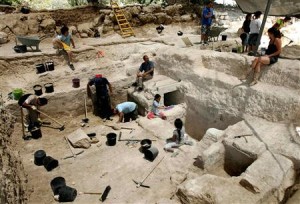Scott Lanser is director at Associates for Biblical Research, a ministry whose purpose is to inform the public on the latest archaeological finds along with each discovery’s biblical perspective. He is also the senior pastor of New Hope Bible Fellowship.
Archaeologists once boasted that the Bible was full of errors, but a slew of discoveries has put a damper on their boasting. Here’s an article by Scott Lanser outlining compelling evidences of the accuracy of the Biblical text.
1. The Tel Dan Stele (900–850 BC) that the United Monarchy under King David existed in history and flatly contradicts the long-held opinions of skeptics who denied that David ever existed.
2. The Meesha Stele (846 BC) – popularly known as the Moabite Stone, it records the revolt of Meesha, King of Moab, against Israel. This incredible stele mentions Omri, King of Israel, and David of the United Monarchy. It even refers to Yahweh, the unique name of the God of Israel!
3. The Nabonidus Cylinder (550 BC). King Nabonidus of Babylonia left a magnificent cuneiform cylinder (wedge-shaped letters inscribed on a clay cylinder) mentioning his elder son, Belshazzar by name. Critics of the Bible had claimed for many years that the account in the book of Daniel was wrong; they said Belshazzar was never a king in Babylon and that Nabonidus was not his father. The discovery of this cylinder clearly showed that these scholars were dead wrong. Indeed, we can now understand the meaning of Daniel 5:16 more precisely where it says, “Now if you can read the writing and make known to me its interpretation, you shall be clothed with purple and have a chain of gold around your neck, and shall be the third ruler in the kingdom” (italics added for emphasis).
This text now makes perfect sense because Nabonidus was in a coregency with his son Belshazzar, who was the crown prince of Babylon. So that would make Daniel the “third ruler in the kingdom.”
4. Caiaphas Ossuary. An ossuary was a box constructed to hold the bones of the dead after decomposition. In 1990 a startling discovery was made that shook biblical scholars and archaeologists alike. In the Peace Forest section of Jerusalem was discovered a burial cave containing twelve ossuaries, one of them being none other than that of Caiaphas, the high priest who presided at the trial of Jesus.
5. Pilate Dedication Stone. In June 1961 an inscription on a limestone block, found at a Roman amphitheater in Caesarea Maritima, rocked the scholarly world. The block, which was once used as a dedication stone of a nearby temple and now reused for seating at the local amphitheater, had an extraordinary inscription. It read: “Tiberieum, (Pon)tius Pilatus, (Praef)ectus Iuda(eae).” Those scholars who questioned Pilate’s existence (and the gospel accounts generally) were silenced with this amazing discovery!
Once again, the full article is here.

 Highlights of recent archeaological finds include:
Highlights of recent archeaological finds include: